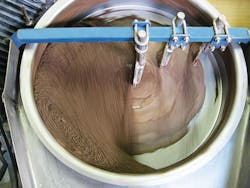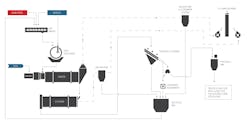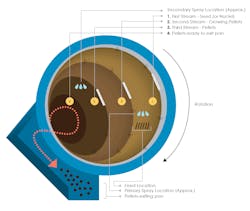Process training for pelletizing plants

The pin mixer-disc pelletizer combination has become an increasingly popular approach to wet granulation, or agitation agglomeration. The technique can be found throughout industrial processing facilities, from fertilizer and soil amendment granulation to the agglomeration of iron ore and other minerals, and even in the production of specialty ceramics and chemicals. This agglomeration method is also frequently employed in the processing of recovered dusts for repurposing or reintegration into the originating process.
Often referred to as pelletizing, the pin mixer-disc pelletizer technique is chosen for its high yield of on-size product, as well as the refined granules the process produces. And while training is often considered as a way to ensure that operators can maximize on-size product, it is often forgotten (but essential) as part of a maintenance and optimization program as well.
Training not only ensures that operators and maintenance personnel know how to operate the equipment properly and safely, but also that they can minimize downtime, avoid upsets, discourage excessive wear or damage to equipment and minimize the amount of product lost to waste.
How the pin mixer-disc pelletizer process works
While pin mixers and disc pelletizers are also used as standalone pieces of equipment, combining the two maximizes the strengths of each, resulting in several advantages, including added control over product size and density, increased production, reduced binder usage and more.
In this setup, the pin mixer combines the solid and liquid feed components into a homogeneous mixture, so materials are pre-mixed before being fed onto the disc pelletizer, maximizing end-product uniformity.
The pin mixer, which is better at densifying material than the disc pelletizer, can also be used to create “seed pellets,” leaving the disc pelletizer with the sole job of growing the granules to their desired size. A simplified process flow diagram is shown in Figure 1.
The added layer of complexity associated with combining the two pieces of equipment makes the already-important need for operator training even more critical to ensure that they understand the relationship between the pieces of equipment.
To assist producers in getting their operations up and running, as well as optimizing their output, FEECO offers process training to pelletizing plants.
The training process
While FEECO provides training for a range of processes, the pin mixer-disc pelletizer agglomeration process is perhaps the most requested. Although the training follows a general format, each training session is tailored to the specific challenges and concerns of the operation at hand. Depending on the level of training required, sessions may range from two to three days and consist of a mix between classroom lectures and hands-on training. A typical training at the customer facility goes as follows.
The FEECO process engineer starts by working with operators in a classroom setting to review the fundamentals of agglomeration (Figure 2). The process engineer covers the underlying principles behind wet granulation/agitation agglomeration, including equipment operation theory, how pellets are made and the many variables operators have at their disposal to control the growth of pellets to the desired size and to make changes to the process as needed (Figure 3). Specific material considerations are also discussed.
Based on what they’ve learned, operators and any other relevant on-site staff work together with the training engineer to come up with a list of potential changes they can make to address the challenges they face with their unique production line.
This is followed by field observations on the actual process to assess the level of operator understanding, observe first-hand the problems operators struggle with and apply the proposed changes.
During this time, the process expert collaborates with operators to make additional modifications to improve the operation, based on what they are seeing. This might include the incorporation of additional spray locations, changes in nozzle type, feed rate adjustments and more.
This field observation continues until the engineer is confident that the operators have the knowledge and tools they need to efficiently troubleshoot and make informed adjustments to their process.
The training engineer then reviews the training session with management to summarize what was covered, what changes were made, and where additional modifications or training might be necessary.
Benefits of training for pelletizer plants
Training in any setting always has the potential to provide process and material benefits. The specific benefits for pelletizing plants include:
Maximized productivity
Trained operators are able to maximize productivity by fine tuning process variables and responding to changes in conditions to maximize the amount of on-size product coming off the line.
Greater product quality control
Because they understand the underlying principles of agglomeration, trained operators are better able to maintain a consistent product quality, responding to fluctuations as they arise.
Enhanced in-house troubleshooting abilities and reduced downtime
Trained operators are also better able to troubleshoot issues when they arise, getting back to normal production quickly and avoiding process upsets when possible.
Having solid in-house troubleshooting capabilities can also help to avoid having to bring in outside help if things go awry.
Improved efficiency
The ability to optimize product quality and the amount of on-size product coming off the line while reducing downtime also means greater overall plant efficiency. This can lead to a range of benefits, including reduced maintenance, energy and labor costs, less off-spec product and more.
Greater equipment longevity
Proper training is essential to promoting equipment longevity. A properly operated and maintained system is much less likely to experience issues. And in the event that an issue arises, personnel have the knowledge and tools at hand to address the situation properly.
Fewer workplace injuries
Similarly, proper training can also result in fewer workplace injuries because operators and maintenance personnel know how to interact with the equipment safely.
Increased employee engagement
Training can also provide a boost in employee engagement and satisfaction. A trained operator is more likely to feel valued and less likely to struggle with day-to-day operations, giving them a sense of accomplishment. The trained operator is also able to assist new operators as they are brought into the operation and ensure that all operators have the same working knowledge. This is especially helpful in facilities that utilize more than one working shift.
Craig Peppin is customer service manager and Carrie Carlson is technical writer at FEECO International. FEECO offers training tailored to process and product goals, as well as unique facility challenges. Training is available to both new and existing facilities (whether they were built by FEECO or not).
FEECO International
About the Author
Craig Peppin
Customer service manager at FEECO International
Craig Peppin is customer service manager at FEECO International.
Carrie Carlson
Technical Writer, FEECO
Carrie Carlson is a technical writer who has been with FEECO for over a decade. She works closely with engineers and process experts to turn complex ideas into easy-to-understand literature.


